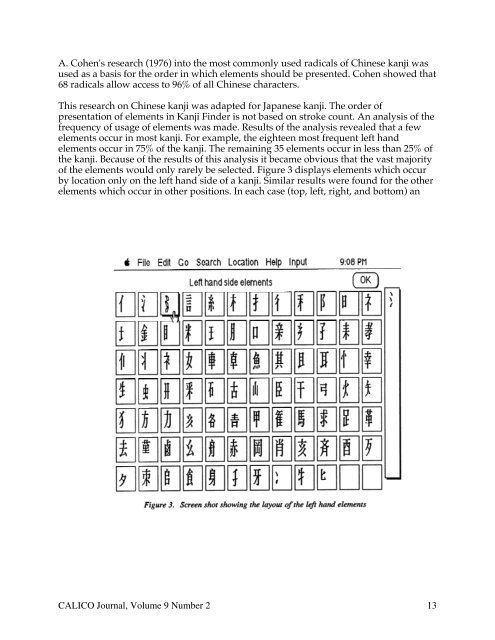Kanji Retrieval by Recursive Location of Elements Using HyperCard
Kanji Retrieval by Recursive Location of Elements Using HyperCard
Kanji Retrieval by Recursive Location of Elements Using HyperCard
Create successful ePaper yourself
Turn your PDF publications into a flip-book with our unique Google optimized e-Paper software.
A. Cohen's research (1976) into the most commonly used radicals <strong>of</strong> Chinese kanji was<br />
used as a basis for the order in which elements should be presented. Cohen showed that<br />
68 radicals allow access to 96% <strong>of</strong> all Chinese characters.<br />
This research on Chinese kanji was adapted for Japanese kanji. The order <strong>of</strong><br />
presentation <strong>of</strong> elements in <strong>Kanji</strong> Finder is not based on stroke count. An analysis <strong>of</strong> the<br />
frequency <strong>of</strong> usage <strong>of</strong> elements was made. Results <strong>of</strong> the analysis revealed that a few<br />
elements occur in most kanji. For example, the eighteen most frequent left hand<br />
elements occur in 75% <strong>of</strong> the kanji. The remaining 35 elements occur in less than 25% <strong>of</strong><br />
the kanji. Because <strong>of</strong> the results <strong>of</strong> this analysis it became obvious that the vast majority<br />
<strong>of</strong> the elements would only rarely be selected. Figure 3 displays elements which occur<br />
<strong>by</strong> location only on the left hand side <strong>of</strong> a kanji. Similar results were found for the other<br />
elements which occur in other positions. In each case (top, left, right, and bottom) an<br />
CALICO Journal, Volume 9 Number 2 13
















